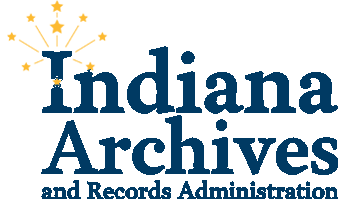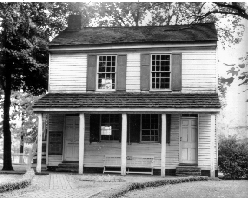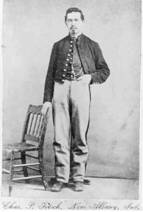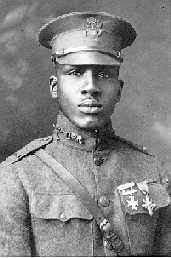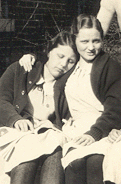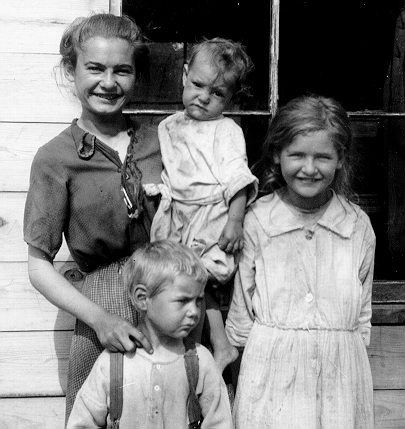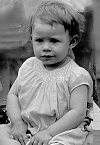SUBJECT | |
| Early Frontier - The Road to Indiana Statehood
Indiana was made a separate territory in 1800, achieving statehood in 1816. Pioneer life in "frontier" Indiana remained difficult for many years. Learn more about early Hoosier ancestors in many of the State Archives Collections. For more on the formation of early Indiana, be sure to visit the collaborative project of the Supreme Court and the Indiana Historical Bureau, The Road to Indiana Statehood. There you will find images of the original 1816 and 1851 Indiana Constitutions. These early treasures reside at the State Archives when they are not on display at the State House during the Legislative session. Land and court records are also a key to learning more about Indiana's early settlers and Native American Families. IUPUI's Digital collections offer a variety of early maps, photographs, and historical collections for those researching Indiana History. For information about Indiana's elected officials and laws, start here. | Territorial Records, Early Military Records, Marion County Court Records, Comptroller Land Records, including the database for Fort Wayne, LaPorte-Winamac, and Vincennes Land Offices on the Indiana Digital Archives. The Supreme Court Database. The Road to Indiana Statehood. Elected Officials and Indiana Laws. |
| Indiana in the Civil War
More than 213,000 men joined Indiana regiments during the Civil War. Indianapolis served as a major staging center for the training and organization of troops. In 1862 the State Fairgrounds was transformed into a prison camp for Confederate soldiers, further involving Hoosier residents. Governor Oliver P. Morton was an influential political leader throughout the war. Indiana was among the first states ready when Lincoln called for volunteers at the start of the conflict. Online patrons can now search the Indiana Civil War Soldiers' database on the Indiana Digital Archives or browse the telegrams of Governor Morton and his staff. A searchable index to the Soldier's and Sailors' home is available, as is one for the Children's Home. Also visit the Indiana State Library's tremendous collections of Civil War Soldiers' photographs. Visitors to the Archives Reading Room will want to research our many other Civil War Collections. Also visit the Sesquicentennial Home Page for information on the 150th anniversary of the Civil War. | Board of Colonization; Supreme Court Records; Indiana Civil War Soldier's Database: Index to the Muster Rolls; Indiana Adjutant General Collections; including Hospital Records, Quartermaster Records, The Indiana Legion, 1862 Draft Records; Camp Morton, Morgan's Raid, Enrollment of Soldiers, Sailors, Widows, and Orphans; Indiana Veterans' Home; The Soldiers' and Sailors' Children's Home. |
| African-American History
The 1851 Indiana State constitution originally included an article 13 that prohibited any "Negro or Mulatto" from settling in Indiana. To enforce this provision, county clerks were ordered to register Negroes and Mulattos already living in Indiana. Registers for Clark, Franklin, Orange, Switzerland, and Vigo counties are available for viewing on the Indiana Digital Archives. Patrons may download images for free. Article 13 was removed and replaced by popular vote in 1881, and by 1896 four African-Americans had already served in the Indiana General Assembly. | Constitution of 1851, Acts of the General Assembly, Board of Colonization, Territorial records, Supreme Court Records, Indiana Fair Employment Practices Commission, Special Census Records including: U.S. Census of Manufacturers, U.S. Census of Agriculture and Social Statistics, Indiana Civil Rights Commission, Civil War, various military collections, State institutions and county records, including Marion County Court Records. |
| Women's History
Indiana granted women the right to vote before the 19th amendment was made to the federal Constitution. Women were also heavily involved in the works of many state agencies and boards, including the Board of State Charities, which campaigned for medical reform, and the Indiana War History Commission, which actually maintained a "Women's Division." Dr. Ada Schweitzer headed the Infant and Child Hygiene Division of the State Board of Health. Among the many programs Schweitzer and her staff sponsored was included the Better Babies contests, a product of the Eugenics movement. | Board of Health, Board of State Charities, Acts of the General Assembly, Governors' Correspondence, Secretary of State, State Election Board, Territorial records, Supreme Court Records, Marion County Court, Civil War, Department of Corrections, Council of Defense records, Indiana War History Commission, Board of Public Safety. |
| Medicine
By the turn of the 20th century, Indiana had created strict guidelines for practicing medicine in Indiana. Hoosier doctors also helped change the way patients were treated, especially in the case of the mentally ill. The Medical History Museum has digitized the scrapbook of William Niles Wishard and made it available through IUPUI's Program for Digital Scholarship. Images and biographical information about many early Indianapolis doctors is a benefit to genealogists as well as academic researchers. | Board of State Charities, Acts of the General Assembly, Governors' correspondence, Board of Medical Registration, Family and Social Services collections (Public Welfare, Mental Health). |
| Medicine: Genetics / Eugenics
In Indiana, arguments of Heredity versus Environment resulted in the implementation of the Eugenics program. The Eugenics movement was an attempt to rid the state of crime, poverty, and other social ills that were believed to be inherited. The movement instituted the sterilization of the socially and mentally "unfit," and contests to promote healthier babies and families. Many Eugenics related documents and photographs from the Indiana State Archives collections may be viewed in the IUPUI online exhibit Fit to Breed, 1907-2007, History and Legacy of Indiana Eugenics. | Board of State Charities, Acts of the General Assembly, Governors' correspondence, Family and Social Services collections (Public Welfare, Mental Health), Board of Health (Infant and Child Hygiene). Also visit the Fit to Breed online exhibit with our partners at IUPUI. |
| Children's Issues
In an attempt to find homes for local orphans, legislators passed laws restricting the placement of children from other states in Hoosier homes without notifying or gaining the permission of Hoosier authorities. Licenses, activity reports, and regular inspections were soon required of any organization that dealt with the welfare and health of any child. In addition to licensing files for orphanages, the State Archives maintains nearly 10,000 files for foster children between the years 1892 and 1910. Additionally there are records for the Indiana Soldiers' and Sailors' Children's Home, the Julia E. Work Home, and the Rose Orphan Home. The Marion County Children's Guardian Home is currently being indexed, as is the correspondence of the State Agent who oversaw the placement of the children. The Indiana Girls and Boys' School may now be searched online. | Board of State Charities and Correction, Acts of the General Assembly, Family and Social Services collections (Public Welfare), Secretary of State (Corporations), misc. Governors' Correspondence, Indiana Soldiers' and Sailors' Orphan's Home, Department of Corrections, Board of Health (Infant and Child Hygiene). Foster Children, 1892-1910. |
| Prison Reform
While not the first state to segregate female prisoners, Indiana was the first state to build an entirely separate Women's Prison. Indiana also segregated prisoners with regard to age and severity of crime, and required regular inspections and reports of all correctional facilities in the Board of State Charities and Correction Collection. Additionally most facilities have register books of inmates, sampled prisoner files, and in many instances mug shots. Indices for individuals serving time at the State Prisons, Women's Prison, and the Indiana Girls and Boys' School may now be searched online. The Indiana Reformatory Records may be located using an in-house card index. Two collections of Pardons and Parole petition files from the Secretary of States office offer and early look at Indiana's philosophy toward a reformatory prison system. These files are supplemented by additional parole requests often found in Governors' papers. The index to the earliest collection of Secretary of State Petitions may now be searched on the Digital Archives. | Department of Corrections, Acts of the General Assembly, Board of State Charities, misc. Governors' Correspondence, Secretary of State (Pardons and Paroles). Territorial Court Records. Supreme Court Records. |
For more information regarding research on these or other collections in the Indiana State Archives, please visit or send us an e-mail.
Note: When sending an email to the Indiana State Archives, please be sure to include a very clear subject heading, i.e, Civil War, Soldier's Home, Hospital Records, Morton Telegrams, etc. Emails without a clear subject heading may be mistaken as spam or a potential virus and be filtered out automatically. If you have not received an initial response from the Indiana State Archives within a few weeks, please resubmit your request.
Disclaimer: The Indiana State Archives is neither an official sponsor of, nor a promoter for, the National History Day projects or themes. This webpage is intended solely as an aid to researching our collections. The Indiana State Archives has no influence on the outcome of this event.
For more Indiana history, researchers are encouraged to visit the Indiana State Library, the Indiana Historical Society, or any of the many local museums and historical societies across Indiana.
For more information on National History Day, please visit the National History Day website, or write to: National History Day, 0119 Cecil Hall, University of Maryland, College Park, MD 20742.
